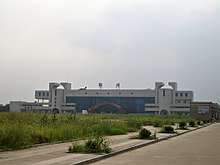Wuhan–Jiujiang railway
The Wuhan–Jiujiang railway or Wujiu railway (simplified Chinese: 武九铁路; traditional Chinese: 武九鐵路; pinyin: wŭjǐu tiělù), is a double-track, electrified railroad in central China between Wuhan in Hubei Province and Jiujiang in Jiangxi Province. The line is 258 km (160 mi) long and follows the south bank of the Yangtze River from Wuchang District in Wuhan to Lushan Station in Jiujiang. Major cities and towns along route include Wuhan, Huarong, Huanggang, Ezhou, Huangshi, Daye Yangxin, Ruichang and Jiujiang.

History

The Wuhan–Jiujiang railway was created from the merger of the Wuhan–Daye and Daye–Shahejie railways in December 1989.[1] The Wuhan–Daye or Wuda railway, from Wuchang to Daye, was built in 1958 to facilitate the transport of iron ore mined in Tieshan District near Daye.[2] The Daye–Shahejie or Dasha railway, from Daye to Shahejie in Jiujiang, was built from 1983 to 1987.[3] The eastern terminus of the line, Lushan Station, is located in Shahejie. The combined Wujiu Line was doubled-tracked from 2003 to 2005 and electrified from 2008 to 2010.[3][4][5] Passenger trains can reach speeds of up to 250 km/h on the line.
The line is used by the frequent D-series high-speed trains running from Wuhan (mostly, the Wuchang Station) to Nanchang and points south and east (throughout Fujian and Zhejiang).
The Wuhan–Jiujiang passenger railway is constructed along a route generally similar to that of the Wuhan–Jiujiang railway; the estimated completion date is 2017. Presumably, when the former is completed, it will take over much of the passenger service currently operating on the latter.
Rail connections
- Wuhan: Beijing–Guangzhou railway, Hankou–Danjiangkou railway, Beijing–Guangzhou–Shenzhen–Hong Kong high-speed railway, Hefei–Wuhan high-speed railway
- Jiujiang: Beijing–Kowloon railway, Hefei–Jiujiang railway, Tongling–Jiujiang railway, Nanchang–Jiujiang intercity railway
See also
- List of railways in China
References
- (Chinese) "第二节 铁路运输单位" 武汉市志(1980-2000) > 经济 下 > 第四十四篇 交通运输 > 第二章 铁路运输 Accessed 2011-12-18
- (Chinese) "湖北省>>黄石市>>铁山区" Accessed 2011-12-18
- (Chinese) "武九铁路大沙段建成" Accessed 2011-12-18
- (Chinese) "中鐵施工的武九鐵路電氣化改造工程(武漢段)開工" 2008-12-22
- (Chinese) "武九铁路电气化改造" Xinhua 2009-12-02